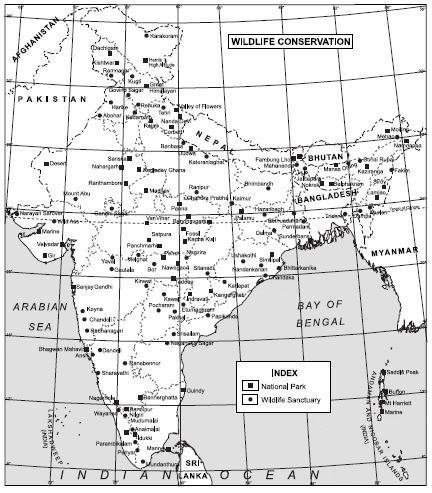Get solutions to all your questions with Aasoka’s top-quality NCERT Solutions for Class 10th Geography. The solutions will benefit students in getting their concepts cleared and they can score the marks they desire in the board exams. The subject matter experts who have designed the NCERT Solutions have kept the latest syllabus and exam pattern in mind. It’s time to grab free access to the solutions now.
“Forest and Wildlife Resources” chapter tells students about the various flora and fauna that are available around us and the reason why these are depleting from our surroundings. Also, there is an explanation about the conservation distribution of wildlife and forests in India. In this chapter, students will read about the steps which common people took to preserve the wildlife and forests resources.
Question 1:
Which of these statements is not a valid reason for the depletion of flora and fauna?
- Agricultural expansion
- Large-scale developmental projects
- Grazing and fuel wood collection
- Rapid industrialisation and urbanisation
Answer:
(c) Grazing and fuel wood collection
Question 2:
Which of the following conservation strategies do not directly involve community participation?
- Joint Forest Management
- Beej Bachao Andolan
- Chipko Movement
- Demarcation of Wildlife Sanctuaries
Answer:
(d) Demarcation of Wildlife Sanctuaries
Question 3:
Match the following animals with their category of existence:
- Black buck
- Asiatic elephant
- Andaman wild pig
- Himalayan brown bear
Answer:
(c) (d) (a) (b)
Question 4:
Match the following:
- Reserved forests
- Protected forests
- Unclassed forests
Answer:
(b) (c) (a)
Question 5:
Answer the following question in about 30 words.
What is biodiversity? Why is biodiversity important for human lives?
Answer:
Biodiversity is a combination of two words– ‘Bio’ meaning life and ‘diversity’ meaning variety. This biodiversity is the number and variety of organisms found within a specified region. It refers to the varieties of species of plants, animals and micro-organisms.
Importance of Biodiversity in human life:
- Biodiversity is our living wealth.
- It has ecological, economic and scientific importance.
- Species of many kinds develop a life support system from each other.
- These affect the climate and ecosystem.
- It produces crops diversity.
- It is an integral part of human culture.
Question 6:
Answer the following question in about 30 words.
How have human activities affected the depletion of flora and fauna? Explain.
Answer:
Many factors have caused the depletion of flora and fauna, out of which, man is the major cause for the ecological imbalance. Human activities have depleted our forests and wildlife resources.
- Expansion of railways, agriculture, commercial and scientific forestry is the major cause of depletion of fauna and flora.
- Large-scale development projects have contributed to the loss of forests, like on river Narmada (Sardar Sarovar Project).
- Mining is another factor of deforestation. It has disturbed the natural habitat.
Question 7:
Answer the following question in about 120 words.
Describe how communities have conserved and protected forests and wildlife in India.
Answer:
In India, forests are home to some communities. They conserve habitats.
- In the Sariska Tiger Reserve situated in Rajasthan, villagers resist mining, by giving example of the Wildlife Protection Act.
- 1,200 hectares of forest area has been declared as the Bhairodev Dakav Sonchuri, by the villagers of Alwar district, Rajasthan. They follow their own code of conduct. They restrict hunting and protect the wildlife from outside encroachments.
- An age old tribal belief is Nature worship. It believes in protection of all natural creations. This type of beliefs have preserved many virgin forests in their pristine form called sacred groves.
- Certain societies preserve a particular tree, which they have been preserving from time immemorial. We consider, peepal and banyan trees as sacred.
- Indian society comprises of diverse cultures, each having their own set of traditional ways of preserving nature and its creations.
- In and around the Bishnoi villages in Rajasthan, herds of Nilgai, Black bucks (Chinkara) and peacocks are protected from hunting.
Question 8:
Answer the following question in about 120 words.
Write a note on good practices towards conserving forest and wildlife.
Answer:
Conservation of wildlife and forest has become essential due to their declining numbers. It preserves our ecological diversity and our life support system.
- The Chipko Movement, started in the Himalayas has avoided deforestation.
- Afforestation has also helped in the conservation of forests.
- Innovative methods of ecological farming are in use now-a-days.
- Farmers and citizen groups like Beej Bachao Andolan in Tehri and Navdanya have helped in traditional conservation.
- Joint Forest Management (JFM) involves the local communities in the conservation of forests.
- Timber Forests are protected.
- Many developmental activities are eco-friendly.
Question 9:
Collect more information on the Wildlife Sanctuaries and National Parks of India and cite their location on the map of India.
Answer:
Location of Wildlife Sanctuaries and National parks on the map of India:

